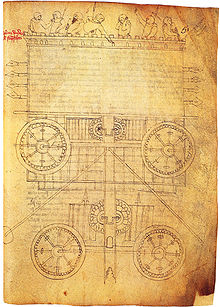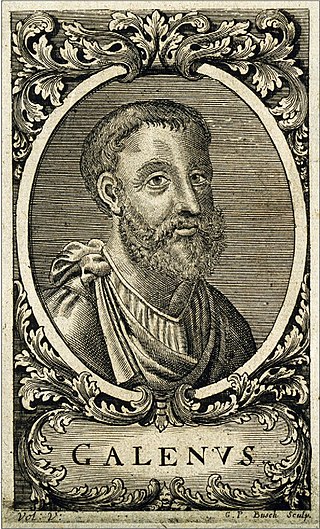
Aelius Galenus or Claudius Galenus, often anglicized as Galen or Galen of Pergamon, was a Roman and Greek physician, surgeon, and philosopher. Considered to be one of the most accomplished of all medical researchers of antiquity, Galen influenced the development of various scientific disciplines, including anatomy, physiology, pathology, pharmacology, and neurology, as well as philosophy and logic.

Andries van Wezel, latinised as Andreas Vesalius, was an anatomist and physician who wrote De Humani Corporis Fabrica Libri Septem, what is considered to be one of the most influential books on human anatomy and a major advance over the long-dominant work of Galen. Vesalius is often referred to as the founder of modern human anatomy. He was born in Brussels, which was then part of the Habsburg Netherlands. He was a professor at the University of Padua (1537–1542) and later became Imperial physician at the court of Emperor Charles V.
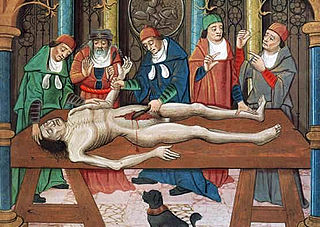
The history of anatomy extends from the earliest examinations of sacrificial victims to the sophisticated analyses of the body performed by modern anatomists and scientists. Written descriptions of human organs and parts can be traced back thousands of years to ancient Egyptian papyri, where attention to the body was necessitated by their highly elaborate burial practices.

Gian Galeazzo Visconti, was the first duke of Milan (1395) and ruled the late-medieval city just before the dawn of the Renaissance. He also ruled Lombardy jointly with his uncle Bernabò. He was the founding patron of the Certosa di Pavia, completing the Visconti Castle at Pavia begun by his father and furthering work on the Duomo of Milan. He captured a large territory of Northern Italy and the Po valley. He threatened war with France in relation to the transfer of Genoa to French control as well as issues with his beloved daughter Valentina. When he died of fever in the Castello of Melegnano, his children fought with each other and fragmented the territories that he had ruled.

Vigevano is a comune (municipality) in the province of Pavia, in the Italian region of Lombardy. A historic art town, it is also renowned for shoemaking and is one of the main centres of Lomellina, a rice-growing agricultural district. Vigevano received the honorary title of city with a decree of Duke Francis II Sforza on 2 February 1532. It is famed for its Renaissance Piazza Ducale in the centre of the town.

Mondino de Luzzi, or de Liuzzi or de Lucci,, also known as Mundinus, was an Italian physician, anatomist and professor of surgery, who lived and worked in Bologna. He is often credited as the restorer of anatomy because he made seminal contributions to the field by reintroducing the practice of public dissection of human cadavers and writing the first modern anatomical text.

In the Middle Ages, the medicine of Western Europe was composed of a mixture of existing ideas from antiquity. In the Early Middle Ages, following the fall of the Western Roman Empire, standard medical knowledge was based chiefly upon surviving Greek and Roman texts, preserved in monasteries and elsewhere. Medieval medicine is widely misunderstood, thought of as a uniform attitude composed of placing hopes in the church and God to heal all sicknesses, while sickness itself exists as a product of destiny, sin, and astral influences as physical causes. On the other hand, medieval medicine, especially in the second half of the medieval period, became a formal body of theoretical knowledge and was institutionalized in the universities. Medieval medicine attributed illnesses, and disease, not to sinful behavior, but to natural causes, and sin was connected to illness only in a more general sense of the view that disease manifested in humanity as a result of its fallen state from God. Medieval medicine also recognized that illnesses spread from person to person, that certain lifestyles may cause ill health, and some people have a greater predisposition towards bad health than others.

A herbal is a book containing the names and descriptions of plants, usually with information on their medicinal, tonic, culinary, toxic, hallucinatory, aromatic, or magical powers, and the legends associated with them. A herbal may also classify the plants it describes, may give recipes for herbal extracts, tinctures, or potions, and sometimes include mineral and animal medicaments in addition to those obtained from plants. Herbals were often illustrated to assist plant identification.
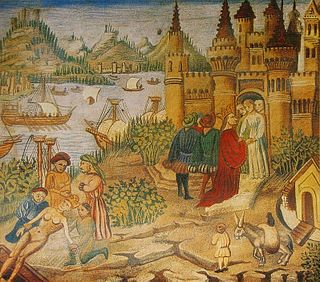
The Schola Medica Salernitana was a medieval medical school, the first and most important of its kind. Situated on the Tyrrhenian Sea in the south Italian city of Salerno, it was founded in the 9th century and rose to prominence in the 10th century, becoming the most important source of medical knowledge in Western Europe at the time.

ʿAlāʾ al-Dīn Abū al-Ḥasan ʿAlī ibn Abī Ḥazm al-Qarashī, known as Ibn al-Nafīs, was an Arab polymath whose areas of work included medicine, surgery, physiology, anatomy, biology, Islamic studies, jurisprudence, and philosophy. He is known for being the first to describe the pulmonary circulation of the blood. The work of Ibn al-Nafis regarding the right sided (pulmonary) circulation pre-dates the later work (1628) of William Harvey's De motu cordis. Both theories attempt to explain circulation. 2nd century Greek physician Galen's theory about the physiology of the circulatory system remained unchallenged until the works of Ibn al-Nafis, for which he has been described as "the father of circulatory physiology".

Maciej Miechowita was a Polish renaissance scholar, professor of Jagiellonian University, historian, chronicler, geographer, medical doctor, alchemist, astrologer and canon in Kraków.
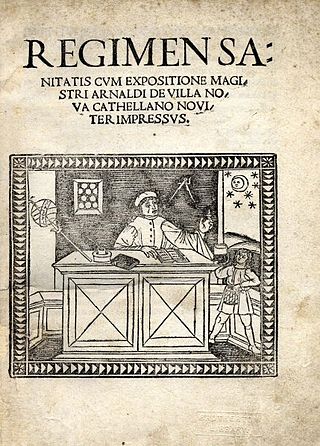
Regimen sanitatis Salernitanum, Latin: The Salernitan Rule of Health, full title: Regimen sanitatis cum expositione magistri Arnaldi de Villanova Cathellano noviter impressus, is a medieval didactic poem in hexameter verse. It is allegedly a work of the Schola Medica Salernitana, a medieval medical school in Salerno. This school founded in the 9th century is considered possibly the oldest medical school, in a southern Italian city, which held the most important medical information, the most famous and notable being Regimen santiatis Salernitanum. Nearly 300 copies of this poem are published, in various languages, for medical professionals.

Jacopo Berengario da Carpi was an Italian physician. His book "Isagoge breves" published in 1522 made him the most important anatomist before Andreas Vesalius.
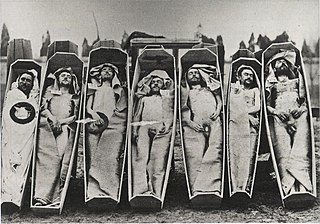
A cadaver or corpse is a dead human body. Cadavers are used by medical students, physicians and other scientists to study anatomy, identify disease sites, determine causes of death, and provide tissue to repair a defect in a living human being. Students in medical school study and dissect cadavers as a part of their education. Others who study cadavers include archaeologists and arts students. In addition, a cadaver may be used in the development and evaluation of surgical instruments.
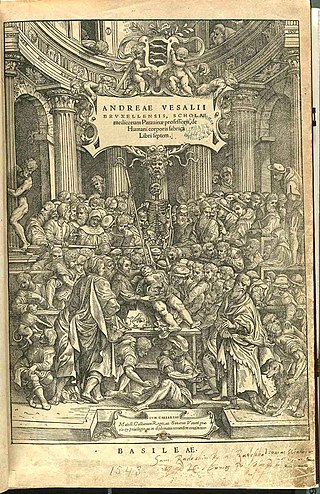
The Medical Renaissance, from around 1400 to 1700 CE, was a period of progress in European medical knowledge, with renewed interest in the ideas of the ancient Greek, Roman civilizations and Islamic medicine, following the translation into Medieval Latin of many works from these societies. Medical discoveries during the Medical Renaissance are credited with paving the way for modern medicine.

Gentile Gentili da Foligno was an Italian professor and doctor of medicine, trained at Padua and the University of Bologna, and teaching probably first at Bologna, then at the University of Perugia, Siena (1322–1324), where his annual stipend was 60 gold florins; he was called to Padua (1325–1335) by Ubertino I da Carrara, Lord of Padua, then returned to Perugia for the remainder of his career. He was among the first European physicians to perform a dissection on a human being (1341), a practice that had long been taboo in Roman times. Gentile wrote several widely copied and read texts and commentaries, notably his massive commentary covering all five books of the Canon of Medicine by the 11th-century Persian polymath Avicenna, the comprehensive encyclopedia that, in Latin translation, was fundamental to medieval medicine. Long after his death, Gentile da Foligno was remembered in the Nuremberg Chronicle (1493) as Subtilissimus rimator verborum Avicenne, "that most subtle investigator of Avicenna's teachings"

Henri de Mondeville was a medieval French surgeon who made a significant number of contributions to anatomy and surgery, and was the first Frenchman to author a surgical treatise, La Chirurgie (1306-1320). Very little is known about the details of his early life. There is some doubt about his birthplace as according to ancient Norman custom, his last name is derived from the place of birth, and is variously spelled as Amondeville, Esmondeville, Mandeville and so on.
John of Gaddesden (1280–1361) was a medieval English physician. He wrote a treatise on medicine titled Rosa Medicinae, also called Rosa Anglica, between 1304 and 1317, considered to be the first English textbook of medicine. John of Gaddesden was also a Roman Catholic theologian, a fellow at Merton College, Oxford, a physician for members of the British royal family, and one of the most celebrated medical authorities of his time. His medical works, alongside those of Gilbertus Anglicus, "formed part of the core curriculum that underpinned the practice of medicine for the next 400 years".

Taddeo Alderotti, born in Florence between 1206 and 1215, died in 1295, was an Italian doctor and professor of medicine at the University of Bologna, who made important contributions to the renaissance of learned medicine in Europe during the High Middle Ages. He was among the first to organize a medical lecture at the university.
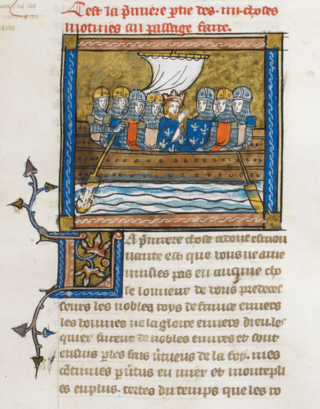
The theme of recovery of the Holy Land was a genre in High–Late Medieval Christian literature about the Crusades. It consisted of treatises and memoranda on how to recover the Holy Land for Christendom, first appearing in preparation for the Second Council of Lyon in 1274. They proliferated following the loss of Acre in 1291, shortly after which the permanent Crusader presence in the Holy Land came to an end, but mostly disappeared with the cancellation of Philip VI of France's planned crusade in 1336 and the start of the Hundred Years' War between England and France the next year. The high point of recovery proposals was the pontificate of Clement V.

